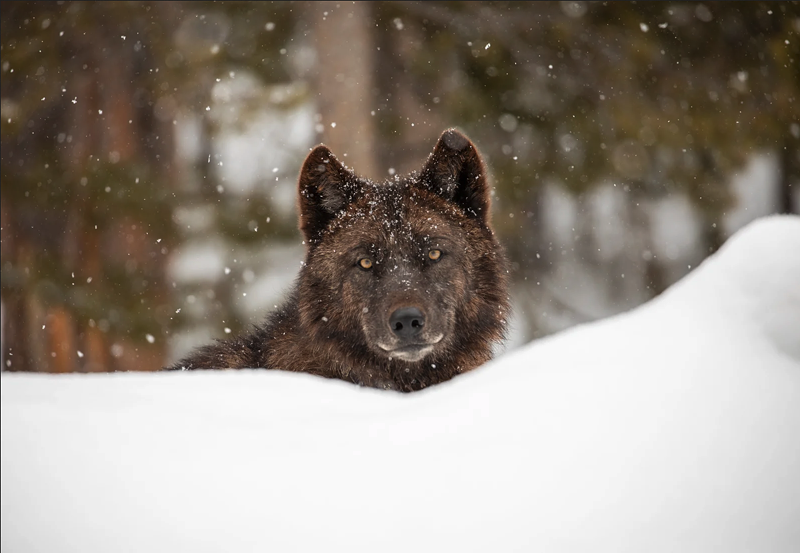Colorado voters narrowly approved Proposition 114, which directs Colorado Parks and Wildlife to reintroduce gray wolves in the state. This victory marked the first time that voters have dictated the reintroduction of a species anywhere in the United States; if the results hold, a significant population of thirty to forty gray wolves will put their paws on the ground in this state over the next three years.
"Together with biologists, ranchers, wildlife watchers and hunters, we will lean in to craft a future where co-existing with wolves is a widely shared value," promises Rob Edward, president of the Rocky Mountain Wolf Action Fund. "We will put science to work to build understanding and trust. As we do, wolves will quietly get to work, restoring balance to our Western wildlands and vitality to our elk and deer herds."
Colorado Parks and Wildlife is already working to meet the proposition's guidelines, which call for a restoration plan by the end of next year. "CPW is committed to developing a comprehensive plan and, in order to do that, we will need input from Coloradans across our state," says CPW director Dan Prenzlow. "We are evaluating the best path forward to ensure that all statewide interests are well represented.”
The initiative was overwhelmingly supported by voters on the state's populous Front Range, while the majority of residents in more rural areas opposed it. Wolves have been considered extirpated since 1945 in Colorado. While a handful of wolves have made their way down to the state from Wyoming, reintroduction advocates say that number is not enough for a self-sustaining population.
For Edward and others, the move to the ballot box was a last-ditch effort. For years, they expected the U.S. Fish & Wildlife Service to reintroduce wolves in Colorado as part of the broader gray wolf recovery effort in the western United States. But when it became clear that the federal government had no such plans, they decided to take the matter directly to voters.
And just days before the election, the feds took another action regarding the future of the animal. On October 29, the Fish & Wildlife Service announced the delisting of gray wolves from the Endangered Species Act (ESA), in a move directed by the Trump administration.
"After more than 45 years as a listed species, the gray wolf has exceeded all conservation goals for recovery," announced U.S. Secretary of the Interior David L. Bernhardt, a native of Colorado. Gray wolves were reintroduced in central Idaho and Yellowstone National Park in 1995. That move, along with strict Endangered Species Act guidelines that prevented the killing of gray wolves, among other measures., led to a gray wolf population in the lower 48 states that now exceeds 6,000 wolves, according to the FWS.
"Colorado Farm Bureau's members are happy to hear about the decision to remove gray wolves from the Endangered Species List," says Don Shawcroft, president of the Colorado Farm Bureau, which opposed 114. "It's a good thing any time a species can be brought back from the brink to healthy population levels."
But a coalition of gray wolf advocates, including the Western Environmental Law Center, considers the delisting premature — and has filed a notice of intent to sue the FWS.
WELC attorney Kelly Nokes points out that while the wolf population may have recovered in the Great Lakes and Northern Rockies, wild populations have not yet made a full recovery in their historical range, which spanned most of the U.S. except for the Southeast. In its suit, WELC plans to argue that Fish & Wildlife did not consider proper science or struggling populations in places like the Pacific Northwest in its decision to delist the gray wolf.
“Wolves are a keystone species whose presence on landscapes regulates animal populations and improves ecosystem health — something the [Fish & Wildlife] Service has acknowledged for at least 44 years," says Nokes.
By delisting wolves, the FWS is renouncing its authority over gray wolf management. State governments will be able to craft their own management plans without having to meet the ESA's stringent protections. Colorado's existing wolf management plan was created in 2004 and reaffirmed in 2016; it was expressly crafted to manage wolves that wandered into the state — not reintroduce them. Under Proposition 114, the CPW must create a new management plan that reintroduces gray wolves by December 31, 2023.
The delisting of wolves as an endangered species won't directly impact Colorado's management plan to restore wolves, except that the state will no longer need to coordinate with the FWS during the reintroduction process.
While the CPW moves forward with its plan in the state, WELC will push its lawsuit against the feds.
"Proposition 114 is a really big step forward for reintroducing wolves in Colorado," Nokes says. "Absent of federal protections, [wolf management] is all in the states' hands. We're really pleased that Colorado voters have voted to restore this keystone species."
[
{
"name": "Air - MediumRectangle - Inline Content - Mobile Display Size",
"component": "12017618",
"insertPoint": "2",
"requiredCountToDisplay": "2",
"watchElement": ".fdn-content-body",
"astAdList": [
{
"adType": "rectangle",
"displayTargets": "mobile"
}
]
},{
"name": "Editor Picks",
"component": "17242653",
"insertPoint": "4",
"requiredCountToDisplay": "1",
"watchElement": ".fdn-content-body",
"astAdList": [
{
"adType": "rectangle",
"displayTargets": "desktop|tablet"
},{
"adType": "rectangle",
"displayTargets": "desktop|tablet|mobile"
}
]
},{
"name": "Inline Links",
"component": "18838239",
"insertPoint": "8th",
"startingPoint": 8,
"requiredCountToDisplay": "7",
"maxInsertions": 25
},{
"name": "Air - MediumRectangle - Combo - Inline Content",
"component": "17261320",
"insertPoint": "8th",
"startingPoint": 8,
"requiredCountToDisplay": "7",
"maxInsertions": 25,
"watchElement": ".fdn-content-body",
"astAdList": [
{
"adType": "rectangle",
"displayTargets": "desktop|tablet"
},{
"adType": "rectangle",
"displayTargets": "desktop|tablet|mobile"
}
]
},{
"name": "Inline Links",
"component": "18838239",
"insertPoint": "8th",
"startingPoint": 12,
"requiredCountToDisplay": "11",
"maxInsertions": 25
},{
"name": "Air - Leaderboard Tower - Combo - Inline Content",
"component": "17261321",
"insertPoint": "8th",
"startingPoint": 12,
"requiredCountToDisplay": "11",
"maxInsertions": 25,
"watchElement": ".fdn-content-body",
"astAdList": [
{
"adType": "leaderboardInlineContent",
"displayTargets": "desktop|tablet"
},{
"adType": "tower",
"displayTargets": "mobile"
}
]
}
]












